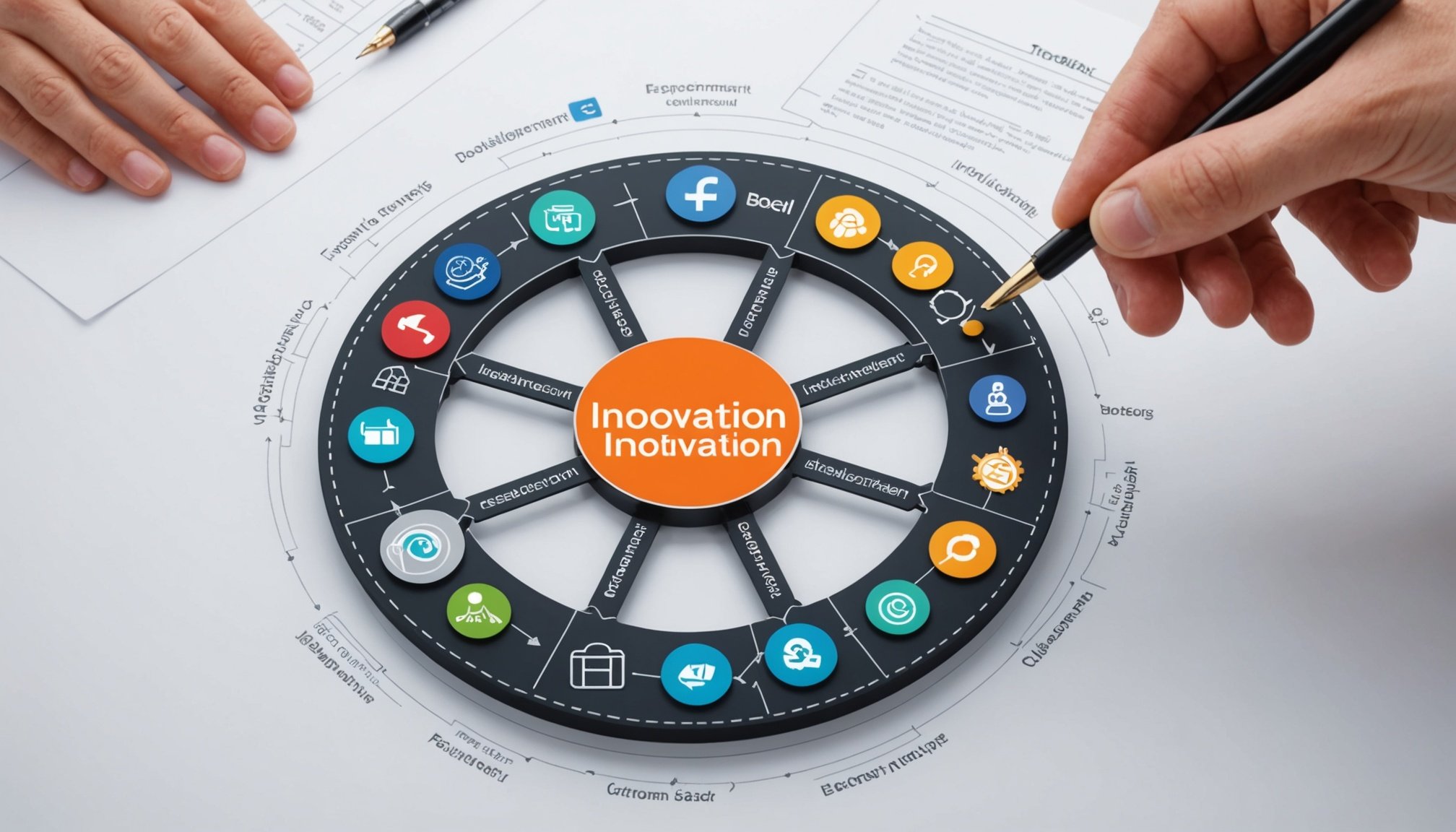Unlocking Innovation: Harnessing Feedback Loops for Advancing Product Development in UK Businesses
In the fast-paced and highly competitive business landscape of the UK, staying ahead of the curve is crucial for long-term success. One of the most effective strategies to achieve this is by leveraging feedback loops to drive innovation and improve product development. In this article, we will delve into the world of feedback loops, exploring how they can be harnessed to enhance product development, foster business growth, and ensure customer satisfaction.
Understanding the Customer Feedback Loop
A customer feedback loop is a continuous cycle of gathering customer feedback and using the insights to improve products and services. This loop is essential for businesses, especially in the SaaS sector, where customer retention and satisfaction are paramount[1][2].
Topic to read : Revolutionizing Customer Support: How UK Tech Startups Use AI to Elevate Experiences
How the Feedback Loop Works
Imagine trying to place an order on an app, but the process gets stuck at the cart stage due to an issue. You click on the ‘Get Support’ button, which triggers the customer feedback program. Here’s what happens next:
- Initial Feedback: You leave feedback about the issue, explaining the problem.
- Action and Resolution: The support team addresses the issue, and the development team works on resolving it.
- Follow-Up: After the issue is resolved, you receive an email asking about your experience with the support team.
- Closing the Loop: If you rate the experience positively, the loop is closed. If not, the process begins again to address your grievances[1].
This continuous loop ensures that customer issues are pinpointed and resolved at every stage of the product life cycle.
In the same genre : Unlocking potential: crafting successful skill development training programs for uk businesses
The Role of Customer Feedback in Product Development
Customer feedback is the lifeblood of product development. It guides businesses in identifying areas that need enhancement and informs how a product evolves over time.
Identifying Areas for Enhancement
By analyzing customer interactions and comments, companies can refine their products to better meet user needs. For instance, if multiple users complain about the complexity of a user interface, the development team can prioritize simplifying it. This direct feedback from users makes the difference between stagnation and growth[2].
Real-World Success Stories
Several UK SaaS companies have achieved significant success by leveraging customer feedback. For example, a SaaS provider specializing in workflow optimization collected extensive feedback about the complexity of their user interface. By implementing these insights, they simplified the interface, leading to a significant increase in user satisfaction and adoption rates[2].
Best Practices for Collecting Customer Feedback
Collecting customer feedback is a cornerstone of achieving meaningful growth. Here are some best practices to ensure you gather valuable insights:
Surveys and Polls
Surveys and polls offer structured mechanisms to glean insights into user sentiments. It’s crucial to craft concise and relevant questions and use platforms like online survey tools to target the right user demographics. Timing and frequency of surveys also play a significant role in maximizing response rates[2].
User Interviews
User interviews provide richer insights than written feedback alone. Preparation is key; establishing an interview script ensures that necessary topics are covered. Active listening and follow-up questions can uncover hidden pain points or innovations[2].
Feedback Forms and In-App Requests
Incorporating feedback forms directly within the application enhances user engagement. This seamless integration encourages spontaneous feedback, often leading to higher response quality and quantity. Ensure the platform is user-friendly and mobile-compatible[2].
Analyzing Customer Feedback Effectively
Analyzing customer feedback is pivotal for extracting valuable data-driven insights.
Categorizing and Prioritizing Feedback
Begin by classifying feedback into categories such as usability, feature requests, or support. Prioritize the most frequently mentioned issues to direct effort and resources efficiently. Use keywords to help identify clusters of concern across user comments[2].
Utilizing Feedback Tools and Software
Tools like Qualtrics or Hotjar enable sophisticated analysis by automating data sorting and visualization. These platforms help harness real-time insights, allowing teams to stay updated on customer sentiments and track patterns in feedback[2].
Implementing Changes Based on Customer Feedback
Incorporating customer feedback into product development is crucial for enhancement strategies.
Translating User Insights into Actionable Goals
Translate user insights into actionable development goals through cross-functional collaboration. Align product features with customer expectations, and establish a framework for feedback implementation to ensure systematic and efficient changes[2].
Maintaining the Feedback Loop
Inform users about modifications based on their input. This practice validates their participation, enhances trust, and strengthens the customer relationship. Providing updates fosters loyalty and continued use of the product[2].
Practical Steps to Create a Customer Feedback Loop
Creating a customer feedback loop involves several key steps:
Step 1: Implement a Customer Feedback Management System
Listening to customers is the first step. Use online methods like website surveys, app surveys, and email campaigns to collect feedback. Offline methods like interviews and focus groups can be time-consuming and are less suitable for continuous feedback loops[1].
Step 2: Start Collecting Feedback Data
Start simple by choosing one or two methods to capture feedback. Use tools like live chat widgets, embedded feedback forms, and CRM tools to collect data from verified customers. Segment users based on their lifetime and purchase value to send targeted surveys[1].
Step 3: Analyze the Feedback Data
Collate the data into a single place, categorize different types of feedback, and dig through each response to record main issues. Group similar issues together to identify common pain points[1].
Step 4: Route the Reports to the Right People
Send the feedback to different teams to act on it quickly. For example, the development team can handle optimization-related feedback, while the support team can handle payment and pricing issues[1].
Table: Comparing Feedback Collection Methods
| Method | Advantages | Disadvantages |
|---|---|---|
| Surveys and Polls | Structured insights, easy to distribute, targets specific demographics | Can be time-consuming to create, may have low response rates if not well-timed |
| User Interviews | Rich, qualitative insights, uncovers hidden pain points | Time-consuming, requires preparation and active listening |
| Feedback Forms | Seamless integration, encourages spontaneous feedback | Requires user-friendly and mobile-compatible platforms |
| Live Chat Widgets | Immediate feedback, can be integrated into various pages | May not capture detailed feedback if not properly designed |
| CRM Tools | Helps in segmenting users, ensures feedback from verified customers | Requires integration with existing systems, can be complex to set up |
Real-World Examples and Success Stories
LEGO’s Data-Driven Approach
LEGO, the renowned toy manufacturer, has successfully implemented customer feedback loops to drive product innovation. By analyzing customer reviews, suggestions, and usage patterns, LEGO has gained valuable insights that led to the creation of new product lines and enhancements to existing offerings. This customer-centric approach has enabled LEGO to stay relevant and meet the evolving needs of its target audience[5].
UK SaaS Companies
Several UK SaaS companies have leveraged customer feedback to achieve significant growth. For instance, a SaaS company specializing in digital marketing solutions harnessed feedback to introduce new feature sets that met evolving user needs. This led to a noticeable uplift in customer loyalty and retention, fostering sustained business growth[2].
Continuous Improvement and Innovation
Continuous improvement is crucial for maintaining a strong market presence and driving sustainable growth.
Iterative Design Process
Involving clients in the design process through open communication encourages valuable feedback and iterative improvements. Sketching and prototyping ideas, testing them with customers, and iterating based on feedback creates a robust process for addressing design issues and refining the product[3].
Leveraging Consultant Insights
Utilizing consultant insights allows businesses to continuously improve products and adapt to changing market demands. Industrial design consultants facilitate timely feedback and iterations that enhance product design, ensuring businesses stay competitive and innovative[3].
Practical Insights and Actionable Advice
Here are some practical insights and actionable advice for implementing effective feedback loops:
- Start Small: Begin with simple feedback collection methods and scale up as you gather more data.
- Use Multiple Channels: Employ a variety of feedback collection methods to ensure comprehensive insights.
- Analyze Thoroughly: Categorize and prioritize feedback to identify common issues and areas for improvement.
- Communicate Changes: Inform users about modifications based on their feedback to enhance trust and satisfaction.
- Integrate Feedback into Product Lifecycle: Use feedback to inform product development at every stage, from planning to post-release.
Harnessing feedback loops is a powerful strategy for advancing product development in UK businesses. By continuously gathering and acting on customer feedback, businesses can refine their products, enhance user experience, and drive sustainable growth.
Key Takeaways
- Customer Feedback is Crucial: It guides product development and helps businesses adapt to user needs.
- Use Varied Feedback Methods: Surveys, user interviews, and feedback forms can provide comprehensive insights.
- Analyze and Prioritize Feedback: Categorize and prioritize feedback to address the most critical issues.
- Maintain the Feedback Loop: Inform users about changes and ensure continuous improvement.
- Integrate Feedback into Decision Making: Use feedback to inform product development and business strategies.
By embracing a customer-centric approach and leveraging feedback loops, UK businesses can unlock innovation, drive growth, and achieve long-term success in a competitive market.











